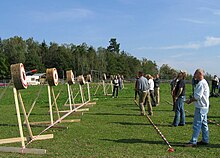Knife throwing
Knife throwing is the art of throwing a knife at a target in such a way that the point of the knife gets stuck in the target.
A knife thrower practices this art professionally or privately. In the circus or at shows, the knives usually land around a person standing directly in front of a target. Knife throwing is more often practiced as a sport and hobby; Knife throwers are organized in more than 25 clubs in Europe, which regularly hold competitions. This sport is popular in the western scene and related to tomahawk throwing .
In movies it often looks like the throwing knife is flying straight ahead. Since knives are not shot, but thrown with an arcuate arm movement, this is not the case: the knife rotates. So the difficulty is to throw the knife so that it hits the target with the blade first. To achieve this, you always throw the same way and find the distance to the target where the knife is stuck. However, there are also throwing techniques in which the knife does not rotate, called no spin . However, these techniques are difficult to learn.
The throwing knife is grasped either by the tip of the blade or by the handle, much like you would hold a hammer. If the blade is sharp, hold it between your thumb and the remaining four fingers. If a shuriken (throwing star) is used instead of the knife , it is easier for the throwing device to get stuck in the target because it has several points, but in Germany, for example, throwing stars are prohibited in contrast to throwing knives.
It is thrown at a target made of wood, preferably on end- grain wood (tree discs stacked on top of one another) or at least five centimeters thick boards with vertical grain, but not on living trees. It is important to ensure that nobody can enter the area unnoticed, and spectators must stand a few meters behind the thrower so that knives that rebound do not pose a threat to them. It is also advantageous if there is no hard surface under the target, in order to protect the knives in the event of missed throws.
To practice, start at a distance of about three meters from the target. It is important to work towards a steady throwing motion and not give additional rotation with the wrist. If the first knives are stuck, the following rule applies: If the handle is pointing upwards, the knife has turned too far, to correct it you go an inch closer to the target. If the handle points downwards, one draws back accordingly.
literature
- Dieter Führer: Handbook of knife and ax throwing . 1st edition. Wieland, Bad Aibling 2011, ISBN 3-938711-53-1 .
- Peter Kramer: Knife throwing like the professionals . 1st edition. Wieland, Bad Aibling 2018, ISBN 978-3-938711-87-3 .
Web links
Individual evidence
- ↑ List of knife throwing associations in the EuroThrowers umbrella organization . Accessed on June 25, 2018.

